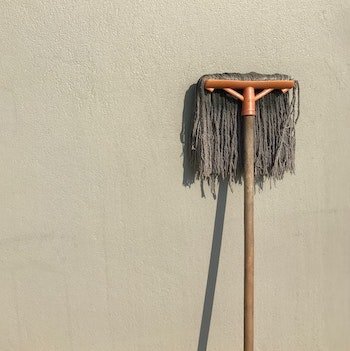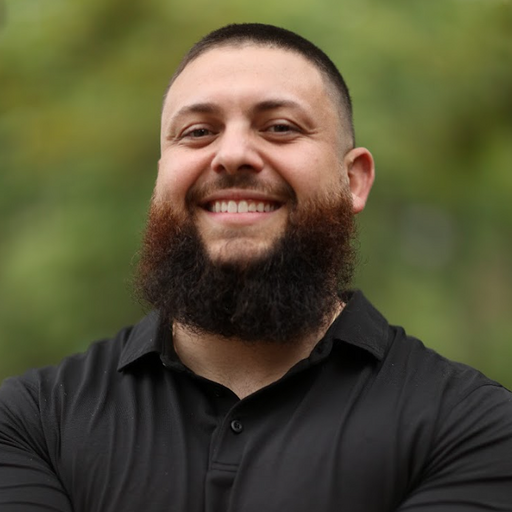Mopping: How To Mop A Floor Correctly

Learn how to mop your floor in this step-by-step guide.
Mopping plays a big role in keeping floors clean.
Traditional mopping is one of the best ways to clean a variety of flooring.
A thorough weekly mopping combined with a powerful cleaning solution provides deep cleaning that a floor needs to stay clean.
If you’re looking for a complete guide on how to mop, then you’ve come to the right place.
Let’s get started.
Benefits Of Mopping Floors
Mopping is a great way to clean vinyl sheet flooring, vinyl tile, and even ceramic or porcelain tile.
Using a floor mop to remove dirt and build-up from your floors will ensure an overall cleaner home.
Floors are exposed to lots of germs, dirt, and bacteria from everyday use.
We constantly step on them, which adds bacteria from our shoes and can even cause mold growth.
Germs build up fast on floors, especially during the cold and flu seasons. This is why it is critical to keep them clean and free of germs and gross mold.
Mopping correctly is a great way to keep your floors clean and free of bacteria and dirt.
Mopping also reduces allergens and dust from building up on your floors.
In the process, you'll keep allergens out of your home and ensure a healthier environment. Apart from mopping to keep your floor clean, you should take your shoes off before you come inside.
This will prevent dirt and germs from your shoes and will improve the cleanliness of your floors. You can leave your shoes in your entryway, or mudroom.

How Often to Clean a Floor
Did you know that on average, you will pay between $3 and $22 per square foot to install floors?
Once they're installed, keeping them clean can be a troublesome task.
Keep reading to learn how often to clean a floor.
Flooring in high-traffic areas (kitchens, dining rooms, bathrooms, hallways) should be thoroughly vacuumed or swept every 3-4 days and mopped 1 time a week.
Mopping plays a big part in keeping floors clean, but regular sweeping or vacuuming is also critical for maintaining the life of your floors.
Regular sweeping and vacuuming removes dirt that can potentially damage the floor itself, when walked on.
The best time to clean your floor with mopping is when the floor doesn’t look clean and shiny.
When it comes with mopping floors, a big mistake people often make is to not use a second bucket for rinsing water.
Most just use only a bucket of washing water and to rinse the mop in the same water that is used to wash the floor.
We recommend using two buckets, one with clean rinsing water, and one for a solution of ½ solution and ½ water.
This ensures that you are properly cleaning your floors and using your buckets to their maximum potential.
How Often Should You Mop Your Floors?
You should mop your floors once a week.
High-traffic areas (kitchen, bathroom, hallways) should be wet mopped 1 time every week.
Having a consistent and frequent floor mopping schedule will help keep your floors clean with less dirt and germs.
What You’ll Need To Mop Like A Pro
- Vacuum cleaner/broom & dustpan
- 2 mop buckets
- Mop
- Dry rag
- Cleaning solution
- Sponge
Simple Mopping Steps + Video Tutorial
1. Choose a mop
First, choose a mop based on the type of flooring you’ll be cleaning.
If the floor has lots of texture, then a string or strip mop will work best.
However, if you have a smooth floor, a sponge mop will work softly and swiftly.
2. Choose a bucket
If you’re using a sponge mop to clean your floors, then any bucket with a handle will work great.
3. Choose a cleaner
Pick a cleaning solution that is made for your specific flooring type.
Don’t use products that say “mop and shine” because they can cause an unwanted buildup.
4. Clear the area
Before you start to mop, you must prepare. Remove all furniture (tables, chairs, rugs, couches).
Before mopping, you want to ensure that every spot on the floor is empty.
As you’re moving the furniture, thoroughly clean them to remove debris and ensure that the floors will be spotless.
Clearing the area beforehand will ensure that things are easier during the cleaning process.
5. Clean before you mop
Before mopping, make sure to prevent your floor from becoming a sticky mess.
Thoroughly sweep or vacuum the floor before touching the mop to the floor.
We recommend using a recommended vacuum mop.
You might also find it a great time to wash away dirty spots that you find.
To do this, use a sponge, soapy water, or your preferred stain remover that is safe for your flooring.
Cleaning before you mop will ensure that the final result will be shiny and spotless.
6. Use warm water
After you prepare your supplies and area to mop your floor, mix your cleaning solution with warm water.
Then, fill the bucket with water at least half-way.
This will ensure that the mop can be fully submerged in the bucket water when you dip it as you clean.
If your mop is dried out, it will need to soak in the warm water for at least 10 minutes before you start cleaning.
7. Fill the buckets
Fill each bucket with warm/hot water which will clean better and faster than colder water.
Then, add the mopping cleaning solution to the wash bucket.
Make sure to not add twice as much solution to double the cleaning power or speed.
Any extra-concentrated wash water won’t improve the clean, but will actually make it more difficult to rinse away.
Simply follow the instructions on the cleaning solution label to ensure that you use the right amount of solution for your clean.
8. Dip the mop
Dip the mop in the bucket, wring it out. You can wring it with a wringer or with your hands.
At this point, the mop should not be dripping wet, but damp. If there is too much water, then the floor can get damaged.
This also increases the time it takes the floor to dry.
9. Start to mop

Work from one end of the floor to the other while moving backward.
Moving backward ensures that you are always standing on an unmopped area to prevent any tracking.
If you are using a sponge mop, we recommend mopping in straight lines.
Make sure that you are thoroughly mopping every part of the floor to ensure a complete clean.
10. Mop in sections
Mopping in small sections helps make getting rid of grime build up much easier.
You should only wipe the floor with the mop 3-4 times which will help spread the cleaning solution over the dirty area.
This is more effective than scrubbing the dirt by hand.
11. Remove stubborn spots
For tough or sticky spots, strongly rub over the spot, applying pressure downwards to remove the dirt and grime.
For hard to reach areas, squat down and scrub with a sponge.
Paper towels can also get the job done in hard to reach areas.
12. Rinse the mopped area
After thoroughly scrubbing each area on the floor, rinse your mop in the rinse bucket.
Dunk the mop in 3-4 times, then wring it out to remove dirty water from the mop head.
13. Continue mopping
Repeat the mopping and rinsing process until you’ve mopped the entire floor.
When the wash or rinse water becomes visibly gray or dirty, empty and refill the buckets.
This ensures that you are using clean water and not water filled with dirt.
Using dirty water makes the rinsing process a complication.
14. Do a final rinse
Now, your floor should be very clean. There should be little or even no cleaning solution residue on the floor.
To ensure that you get the most out of your clean, mop over the entire floor 1 more time with only fresh hot water.
15. Let everything dry
After your thorough mopping session, make sure that everyone in your home knows not to step on the drying floor.
Thoroughly rinse out your mop, mop bucket, and let them completely dry before putting them away.
Before walking on your fresh floor, let it dry completely.
16. Put back furniture
Once the floor is dry, put everything you removed from the floor back on and enjoy your new and freshly cleaned floors.
Frequently Asked Questions
How Often Should Mops Be Replaced?
Mops should be replaced every six months to a year, depending on how often they are used. If the mop is being used constantly, it should be replaced more frequently than if it is only being used once a week.
How Long Do Mops Last?
Mops usually last for around six to twelve months, but this can also vary depending on how often they are used. How long do mops last may depend on the quality of the mop, but most can be easily replaced when needed if you have the right information.
How to Know When Mops Need Replacing?
Mops need to be replaced when they start falling apart and becoming unusable or after six months to a year.
How often should mops be replaced may depend on how long you have had the mop, and how well it is made. If you are unsure whether or not your mop needs replacing, take a look at these signs:
How Do Mops Break?
When choosing what type of vacuum cleaner will work best for your home there is a lot to consider.
How often should you vacuum? How long will the vacuum last? What type of floors do you have in your home? How much money are you willing to spend on a vacuum cleaner?
The most common way mops break is by becoming stained and unusable.
If the mop head becomes too dirty, it will be difficult to clean the floors. The mop may also start to smell bad and become less effective at cleaning the floors. When this happens, it is time to replace the mop.
Another way mops break is by becoming too wet. If the water builds up in the mop head, it can easily fall apart and become unusable. This can also happen if the mop is not being used properly or if it is not stored in a dry place.
Why Should I Replace My Mop?
There are a few reasons why you should replace your mop. The most common reason is because the mop head becomes too dirty and stained, making it difficult to clean the floors.
Another reason is because the mop becomes too wet and falls apart, becoming unusable.
Finally, when the mop starts to smell bad or lose its effectiveness at cleaning floors, it may be time to replace the mop. How often should you change your vacuum cleaner bags?
Conclusion
Mopping is a great way to keep your floors clean, prevents bacteria, destroys mold, and prevents scratches.
Mopping seems like a hassle, but it is necessary to keep your home clean and fresh.
How To Clean Tile Floors

Now you can order cleaning services
in just 5 minutes















